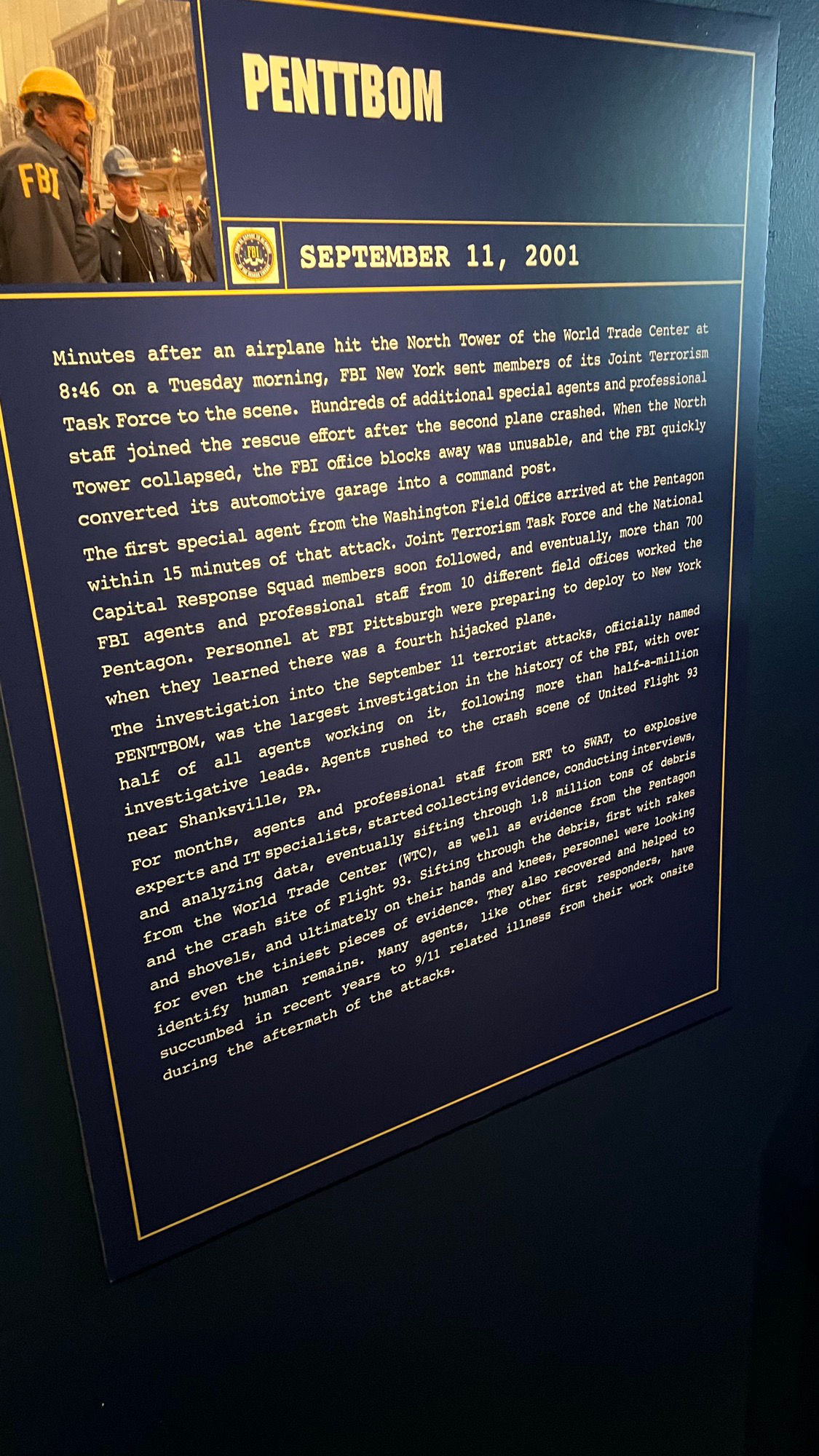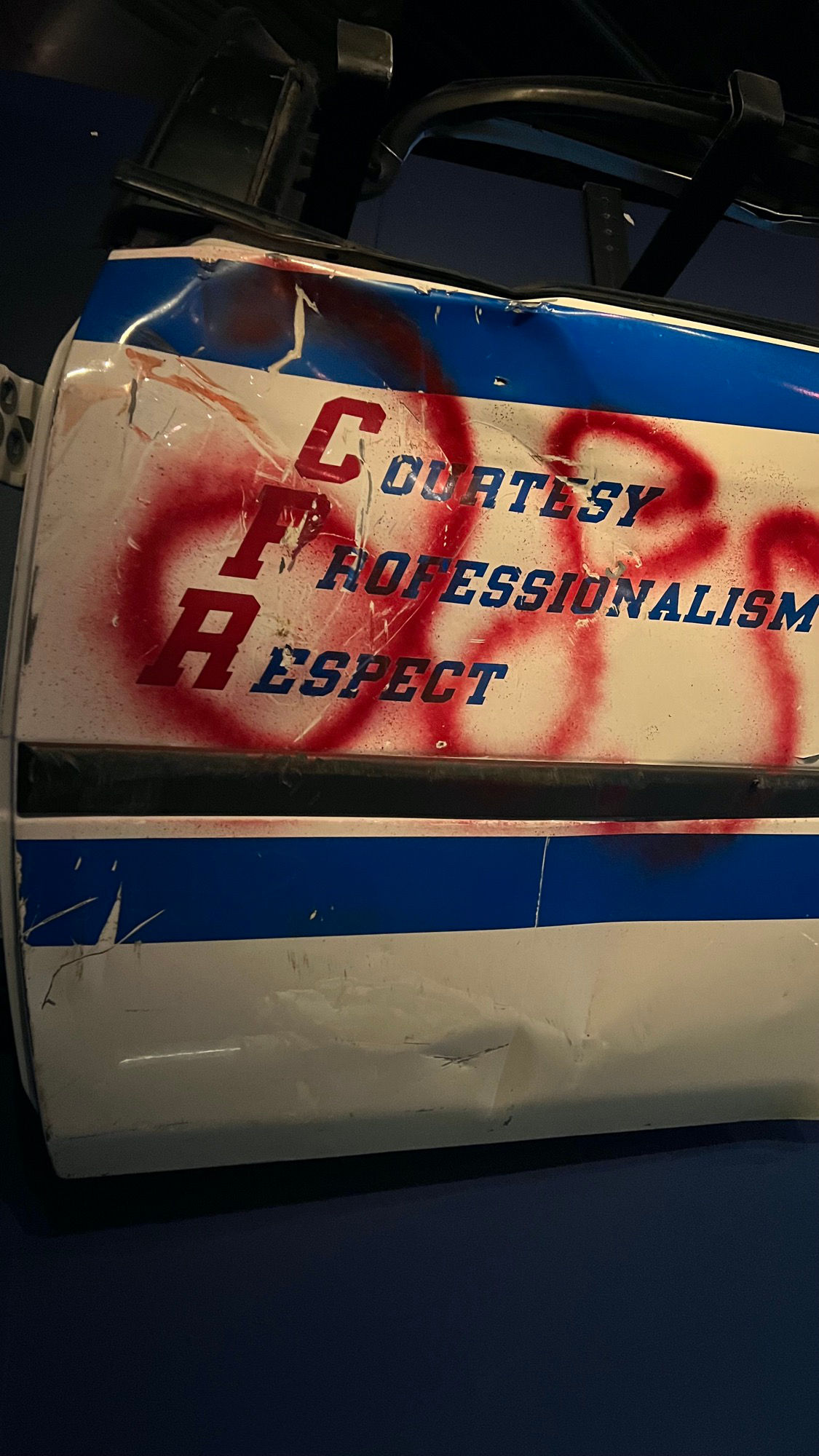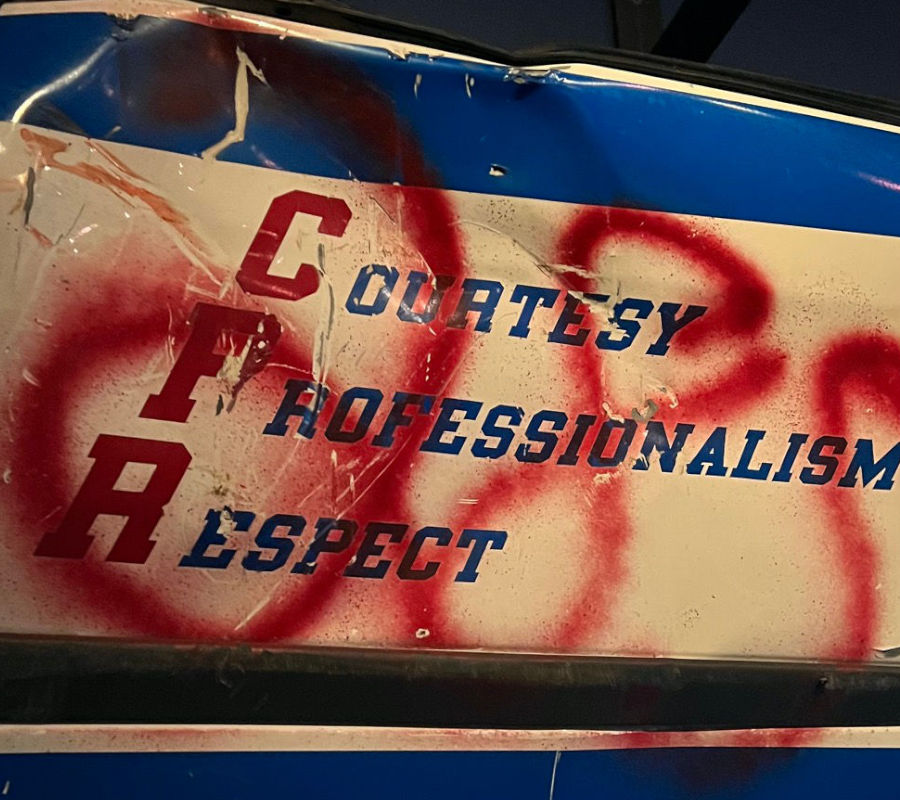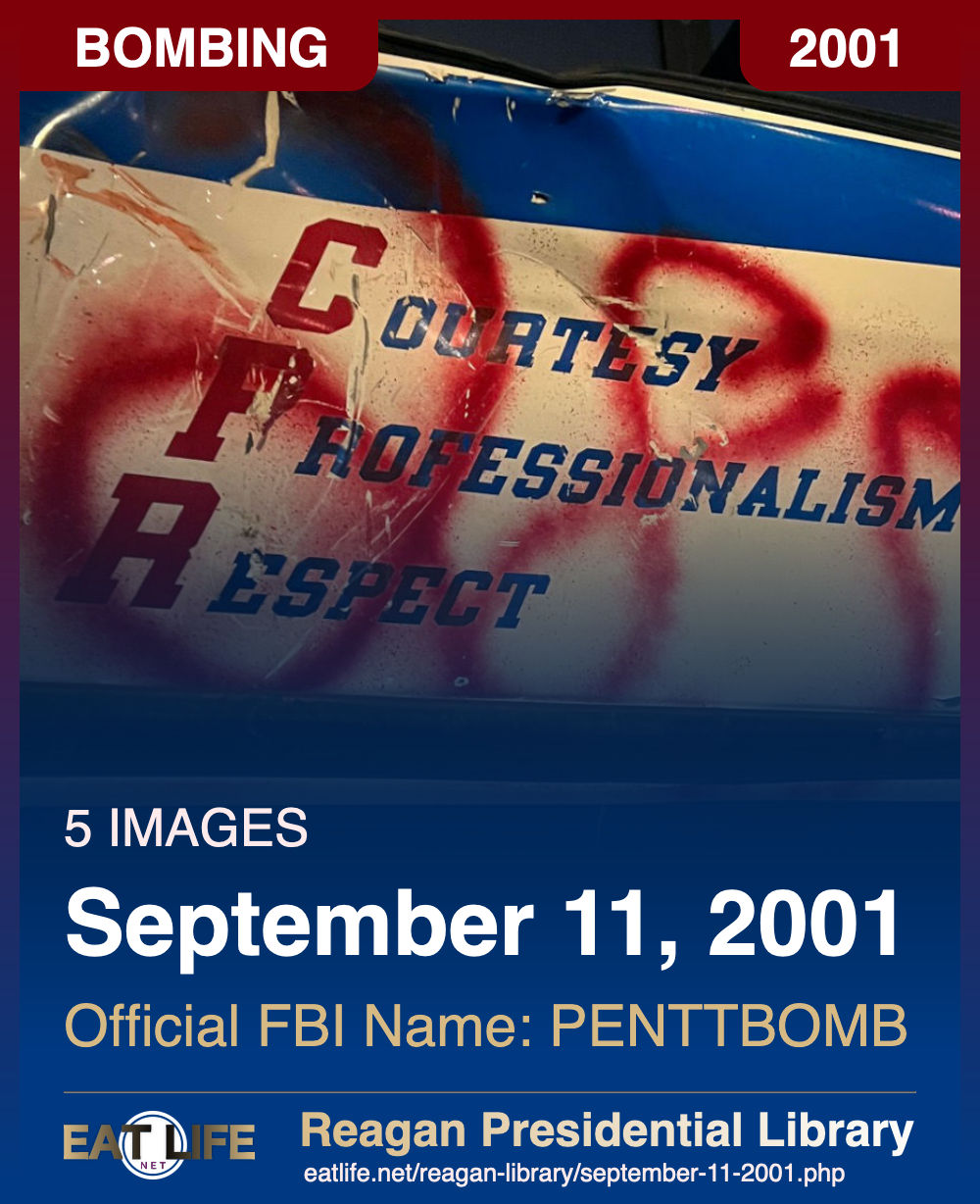
PENTTBOM
Minutes after an airplane hit the North Tower of the World Trade Center at 8:46 on a Tuesday morning, FBI New York sent members of its Joint Terrorism Task Force to the scene. Hundreds of additional special agents and professional staff joined the rescue effort after the second plane crashed. When the North Tower collapsed, the FBI office blocks away was unusable, and the FBI quickly converted its automotive garage into a command post.
The first special agent from the Washington Field Office arrived at the Pentagon within 15 minutes of that attack. Joint Terrorism Task Force and the National Capital Response Squad members soon followed, and eventually, more than 700 FBI agents and professional staff from 10 different field offices worked the Pentagon. Personnel at FBI Pittsburgh were preparing to deploy to New York when they learned there was a fourth hijacked plane. Agents rushed to the crash scene of United Flight 93 near Shanksville, PA.
The investigation into the September 11 terrorist attacks, officially named PENTTBOM, was the largest investigation in the history of the FBI, with over half of all agents working on it, following more than half-a-million investigative leads.
For months, agents and professional staff from ERT to SWAT, to explosive experts and IT specialists, started collecting evidence, conducting interviews, and analyzing data, eventually sifting through 1.8 million tons of debris from the World Trade Center, as well as evidence from the Pentagon and the crash site of flight 93. Sifting through the debris, first with rakes and shovels, and ultimately on their hands and knees, personnel were looking for even the tiniest pieces of evidence. They also recovered and helped to identify human remains. Many agents, like other first responders, have succumbed in recent years to 9/11 related illness from their work onsite during the aftermath of the attacks.

United Airlines Flight 175, scheduled to fly from Boston to Los Angeles, was flown into the South Tower of the World Trade Center on 9/11.



FBI9/11 Investigation
They were the most lethal terrorist attacks in history, taking the lives of nearly 3,000 Americans and international citizens and ultimately leading to far-reaching changes in anti-terror approaches and operations in the U.S. and around the globeOur investigation of the attacks of 9/11-code-named "PENTTBOM," short for Pennsylvania, Pentagon, and Twin Towers Bombing-was our largest case ever. At its peak, more than half our agents worked to identify the hijackers and their sponsors and, with other agencies, to head off any possible future attacks. We followed more than half-a-million investigative leads, including several hundred thousand tips from the public. The attack and crash sites also represented the largest crime scenes in FBI history.
The events of 9/11 are forever etched in the minds of anyone old enough to remember the day. Those who were on the East Coast recall that it was a brilliant, clear morning. Then, at 8:46 a.m., American Airlines Flight 11 crashed into the North Tower of the World Trade Center in New York City.
In a meticulously planned attack, terrorists hijacked four airliners. They flew three of the planes into buildings: the twin towers of the World Trade Center in New York and the Pentagon in Arlington, Virginia. They crashed the fourth plane in rural Pennsylvania. The attacks killed 2,976 people and injured thousands more. Today, many first responders are still dealing with adverse health effects from working in toxic conditions.
Immediately after the attacks, the FBI's top job was to identify the attackers and prevent another incident. Experts in terrorism, evidence collection, and other specialties worked feverishly to determine what had happened and who was responsible.
The FBI also coordinated with its partners in law enforcement and the intelligence community domestically and abroad as it launched its most ambitious investigation ever.
Within minutes, officials at FBI Headquarters in Washington, D.C., activated the Strategic Information and Operations Center. By the end of the day, the FBI had established command posts for each of the three crash sites.
Thousands of agents interviewed witnesses and sources. They tracked down clues and tips worldwide to determine what had happened, who did it, and how future acts could be prevented. The FBI started identifying the 19 terrorists within hours.
Then-FBI Director Robert S. Mueller, III broke with routine and based the massive investigation out of FBI Headquarters instead of a field office. The PENTTBOM Team coordinated the investigation out of a basement office, where dozens of agents would build a case against those responsible.
The case, which remains open, revealed extraordinary acts of courage and selflessness among the spectrum of responders. And it forever changed the way the FBI works with law enforcement and intelligence community partners to keep Americans safe in the U.S. and abroad.
By the Numbers
More than 4,000 special agents and 3,000 professional employees helped in the recovery and subsequent investigation of the 9/11 attacks, which challenged the FBI to deploy its assets efficiently and in innovative ways. All FBI Headquarters divisions, field offices, and nearly every unit at the FBI Laboratory contributed. Among the efforts:
- In New York, more than 1,000 FBI employees from 55 of the 56 field offices worked to recover victims, evidence, and personal belongings.
- At the Pentagon, 155 FBI employees from eight field offices recovered evidence.
- In Pennsylvania, 152 FBI employees from eight field offices recovered evidence.
- Special agents and personnel in at least 30 of the FBI's foreign offices tracked down leads and worked with international partners.
- The FBI responded to more than 500,000 investigative leads.
- Special agents conducted more than 167,000 interviews.
- The FBI collected and processed more than 150,000 pieces of evidence.
- Photographers took more than 170,000 pictures.
- Computer experts examined more than 35 terabytes of data in the first 30 days of the investigation alone.
- More than 70 agents and professional staff worked on the core investigative team.
- Scores of FBI Laboratory personnel helped identify victims and hijackers through DNA.
- Dozens of document experts reviewed more than 1,600 small or damaged pieces of paper.
- Dozens of fingerprint examiners received more than 3,800 pieces of evidence and conducted more than 126,600 comparisons.
- Five FBI cadaver dogs worked at the Pentagon.
- Highly skilled FBI artists developed models of the sites and produced dozens of graphics.
- Hazardous materials specialists from numerous field offices worked the three sites.
- Explosives experts examined plane wreckage and building debris for evidence of bombs.
- FBI pilots transported teams, equipment, and specialists to different locations.
- Technical specialists restored the New York Field Office's computer and phone systems and provided emergency communication systems in Virginia and Pennsylvania.
- FBI SWAT teams provided security at all three sites, and Hostage Rescue Teams evaluated security at several locations.
- Specialists helped recover audio and data from cockpit voice and flight data recorders and analyzed other audio and video recordings.
- The FBI's Office for Victim Assistance (now the Victim Services Division) was created to serve thousands of victims and their families.
The Terrorists
The 19 men who hijacked and crashed the four planes were all trained by al Qaeda. Three of the suspected pilots-Mohamed Atta, Marwan Al-Shehhi, and Ziad Jarrah-were part of an al Qaeda cell based in Hamburg, Germany. All four pilots took flying lessons in the United States.Fifteen of the hijackers came from Saudi Arabia, two from the United Arab Emirates, one from Egypt, and one from Lebanon. The oldest was 33; the rest were between 20 and 29. The group also included two sets of brothers: Wail and Waleed Al-Shehri on American Flight 11, and Nawaf and Salem Al-Hazmi on American Flight 77.
The hijackers began entering the United States in January 2000 to advance the plot. All 19 were in the country by early July 2001.
The Flights: A Timeline

The Victims
Nearly 3,000 people died on 9/11. A 2-year-old girl on Flight 175 died with her parents on their way to Disneyland. An 85-year-old man on Flight 11 died alongside his wife on their way to her son's wedding. Eight children died, including three 11-year-olds on Flight 77 taking a school trip. Three college students died on Flight 93.The victims lived in New York, Washington, D.C., and 27 states. One financial services firm lost 658 employees. The U.S. Army lost 75 men and women. More than 400 first responders, including 60 law enforcement officers, were killed. Nearly 3,000 children lost a parent. The FBI family lost two members that day: Special Agent Lenny Hatton was assisting firefighters was inside the World Trade Center when the buildings collapsed. Former Special Agent John O'Neill was also killed in the collapse.
Today, FBI Director Wray requires new special agents and intelligence analysts to visit the National September 11 Memorial & Museum to remind them of their role to protect the American people and to remember the sacrifices of their brothers and sisters who rose to the occasion and responded on 9/11.
"When you have tough days-and I guarantee you, you will have tough days-remember this day and let it bring you back to the core of your job," Wray tells new agents and analysts. "The stakes of the work we do. The people we do the work with. The people we do the work for. If you always keep those things front and center you'll have an incredibly rewarding career at the Bureau and you'll leave the organization even better than when you found it. And our country will be better for it, too."
WIKIPEDIA The September 11 Attacks
Commonly known as 9/11, were four coordinated Islamist suicide terrorist attacks carried out by al-Qaeda against the United States in 2001. That morning, 19 terrorists hijacked four commercial airliners scheduled to travel from the New England and Mid-Atlantic regions of the East Coast to California. The hijackers crashed the first two planes into the Twin Towers of the World Trade Center in New York City, two of the world's five tallest buildings at the time, and aimed the next two flights toward targets in or near Washington, D.C., in an attack on the nation's capital. The third team succeeded in crashing into The Pentagon, the headquarters of the U.S. Department of Defense in Arlington County, Virginia, while the fourth plane crashed in rural Pennsylvania following a passenger revolt. The attacks killed nearly 3,000 people and instigated the multi-decade global war on terror.
1The first impact was that of American Airlines Flight 11, which crashed into the North Tower of the World Trade Center complex in Lower Manhattan at 8:46 a.m.
2Sixteen minutes later, at 9:03, the World Trade Center's South Tower was hit by United Airlines Flight 175. Both 110-story skyscrapers collapsed within an hour and forty-one minutes, bringing about the destruction of the remaining five structures in the WTC complex and several other nearby buildings.
3A third flight, American Airlines Flight 77, crashed into The Pentagon at 9:37 a.m., causing a partial collapse.
4The fourth and final flight, United Airlines Flight 93, flew in the direction of the capital. Alerted to the previous attacks, the passengers retaliated in an attempt to take control of the aircraft, forcing the hijackers to crash the plane in a Stonycreek Township field, near Indian Lake and Shanksville, at 10:03 a.m. Investigators determined that Flight 93's target was either the United States Capitol or the White House.Within hours of the attacks, the Central Intelligence Agency had determined that al-Qaeda was responsible. The United States formally responded by launching the war on terror and invading Afghanistan to depose the Taliban, which rejected the conditions of U.S. terms to expel al-Qaeda from Afghanistan and extradite its leaders. The U.S.'s invocation of Article 5 of the North Atlantic Treaty-its only usage to date-called upon allies to fight al-Qaeda. As U.S. and NATO invasion forces swept through Afghanistan, al-Qaeda leader Osama bin Laden disappeared into the White Mountains, eluding captivity by Western forces.
Although bin Laden initially denied any involvement, in 2004 he formally claimed responsibility for the attacks. Al-Qaeda's cited motivations included U.S. support of Israel, the presence of U.S. military bases in Saudi Arabia and sanctions against Iraq. The nearly decade-long manhunt for bin Laden concluded on May 2, 2011, when he was killed during a U.S. military raid after being tracked down to his compound in Abbottabad, Pakistan. The war in Afghanistan continued for another eight years until the agreement was made in February 2020 for American and NATO troops to withdraw from the country, and the last members of the U.S. armed forces left the region on August 30, 2021, resulting in the return to power of the Taliban.
- Not including the hijackers, the attacks killed 2,977 people, injured thousands more and gave rise to substantial long-term health consequences while also causing at least $10 billion in infrastructure and property damage.
- It remains the deadliest terrorist act in human history as well as the single deadliest incident for both firefighters and law enforcement personnel in the history of the United States, causing the deaths of 343 and 72 members respectively.
- The loss of life stemming from the impact of Flight 11 secured its place as the most lethal plane crash in aviation history followed by the death toll incurred by Flight 175.
- The destruction of the World Trade Center and its environs seriously harmed the U.S. economy and induced global market shocks.
- Many other countries strengthened anti-terrorism legislation and expanded their powers of law enforcement and intelligence agencies.
- Cleanup of the World Trade Center site (colloquially "Ground Zero") took eight months and was completed in May 2002, while The Pentagon was repaired within a year.
- After delays in the design of a replacement complex, construction of the One World Trade Center began in November 2006; it opened in November 2014.
- Memorials to the attacks include the National September 11 Memorial & Museum in New York City, The Pentagon Memorial in Arlington County, Virginia, and the Flight 93 National Memorial at the Pennsylvania crash site.












